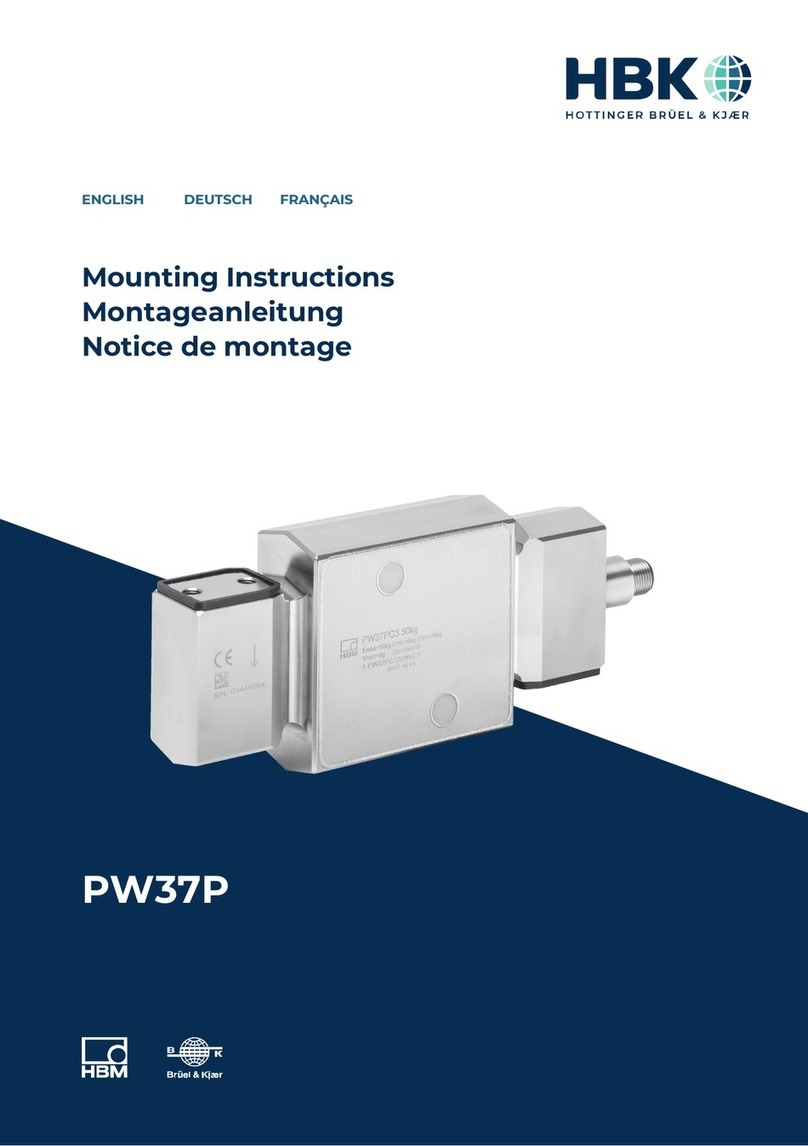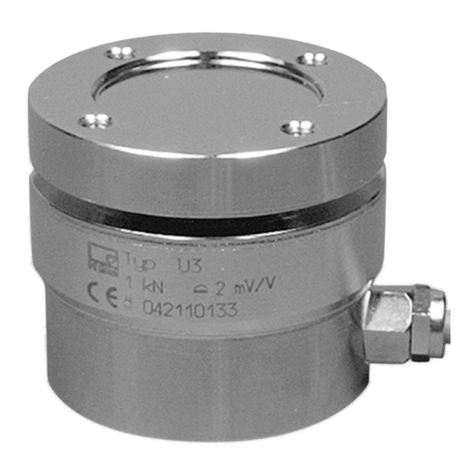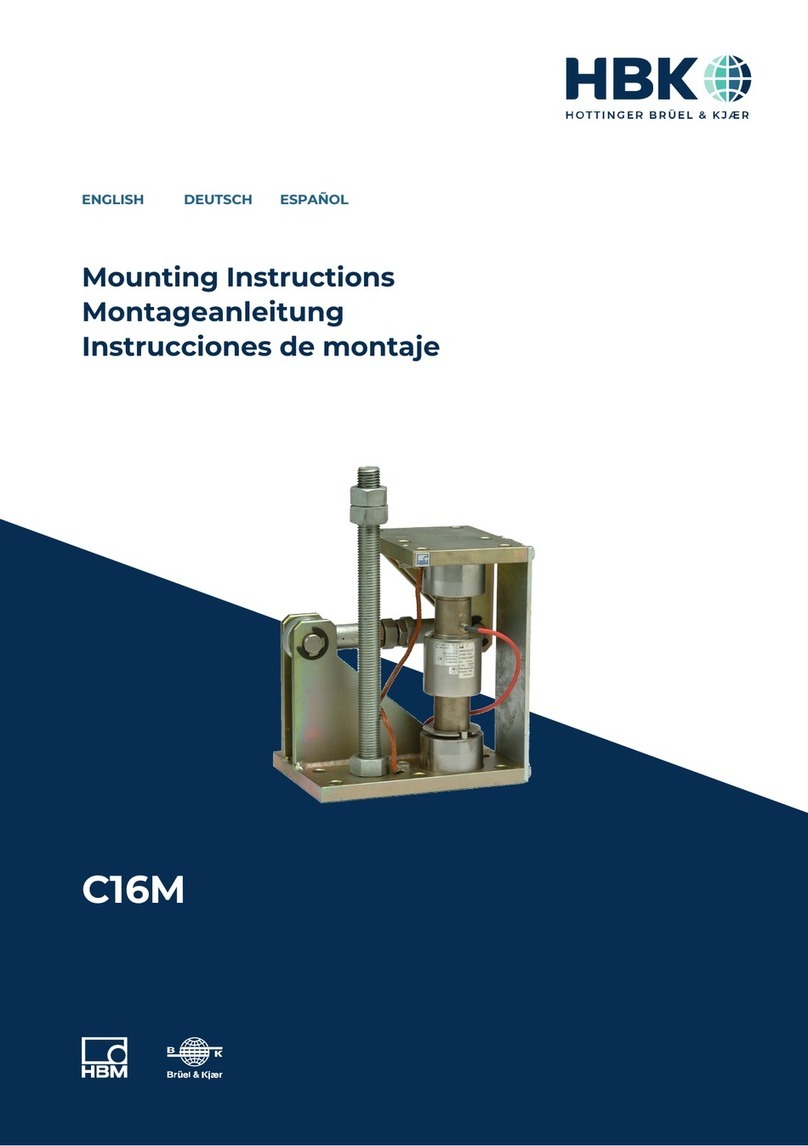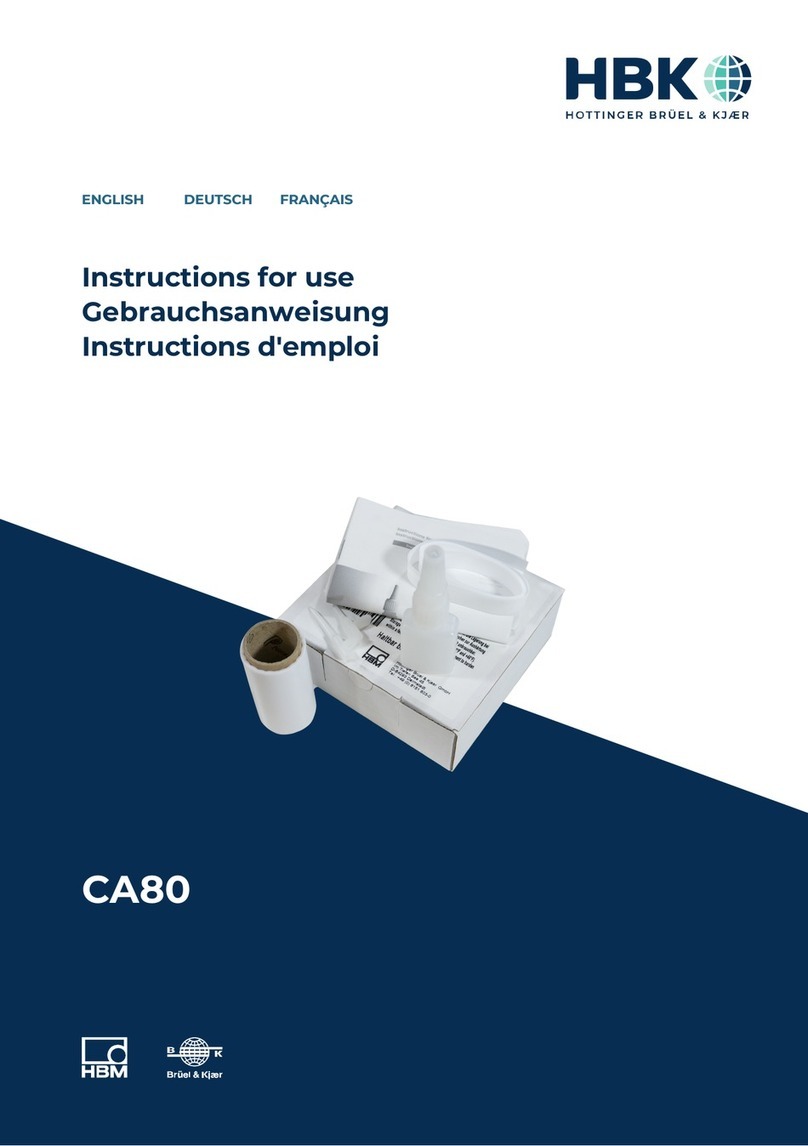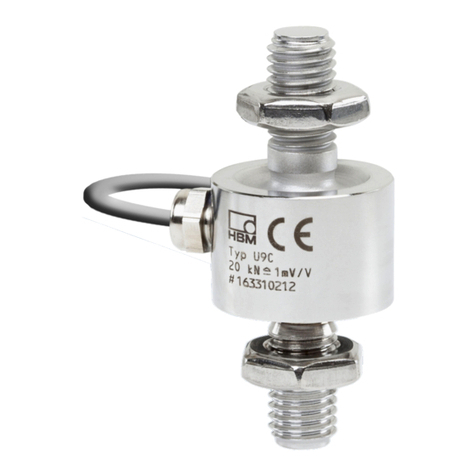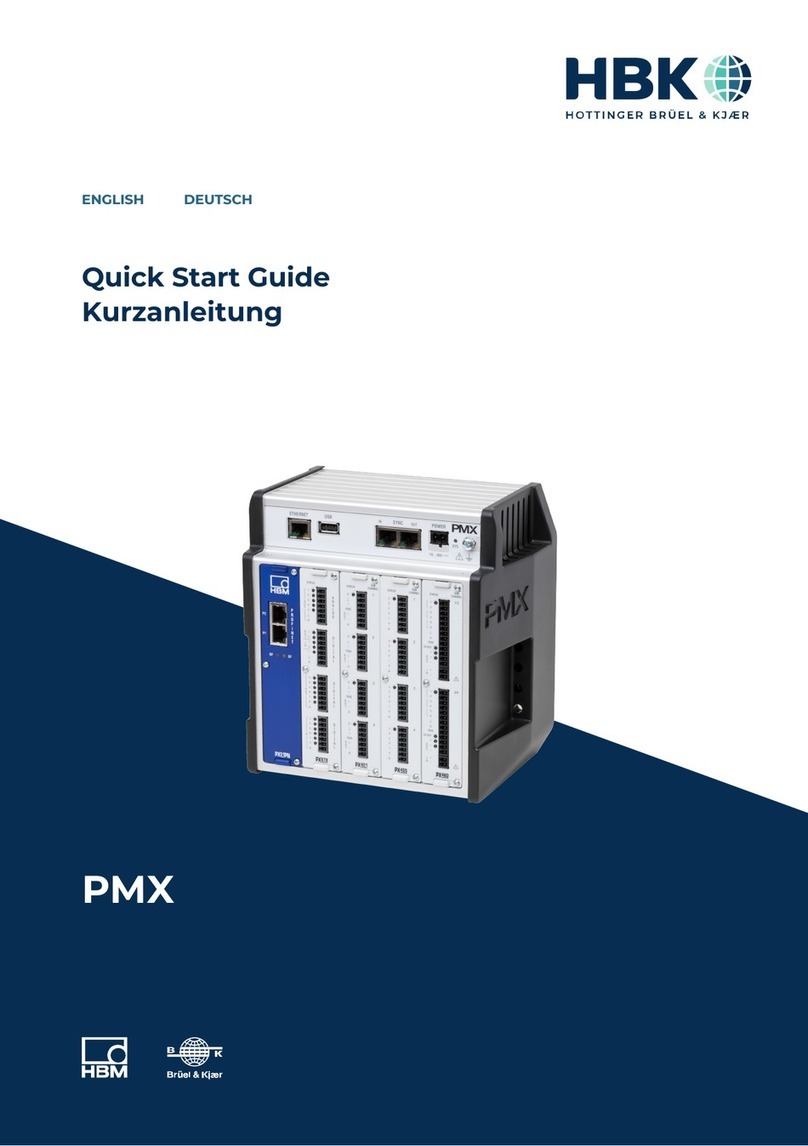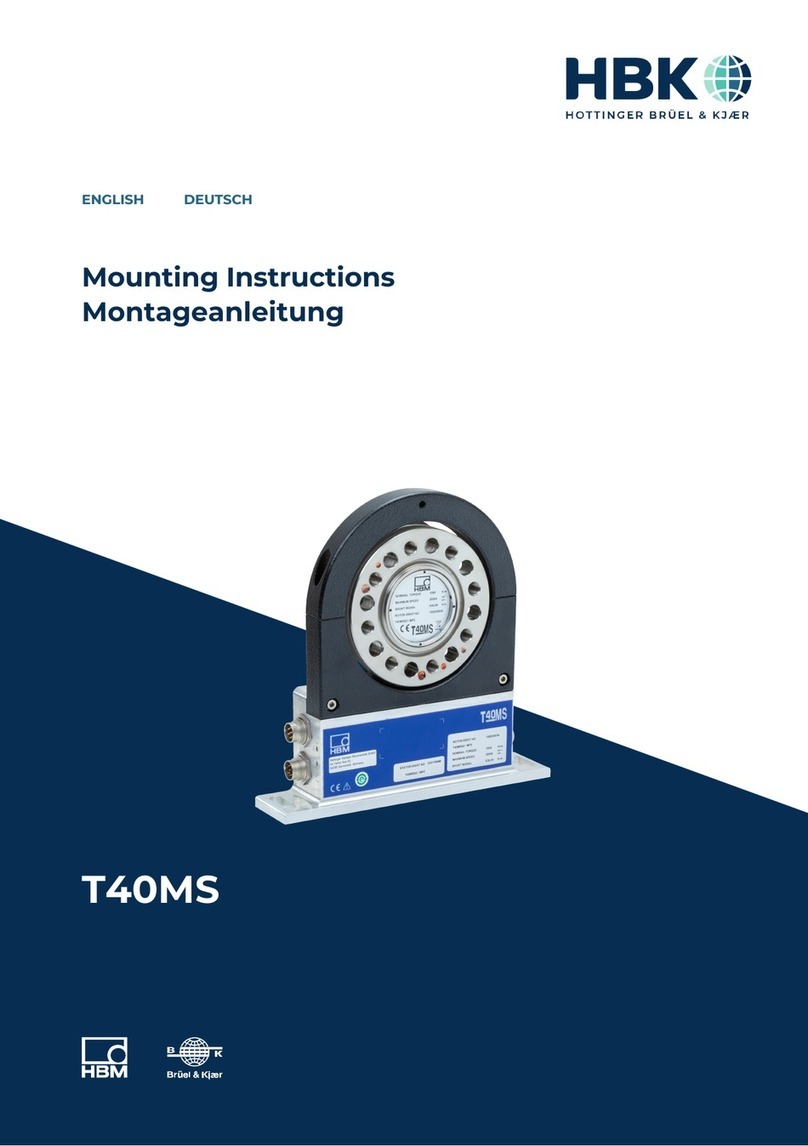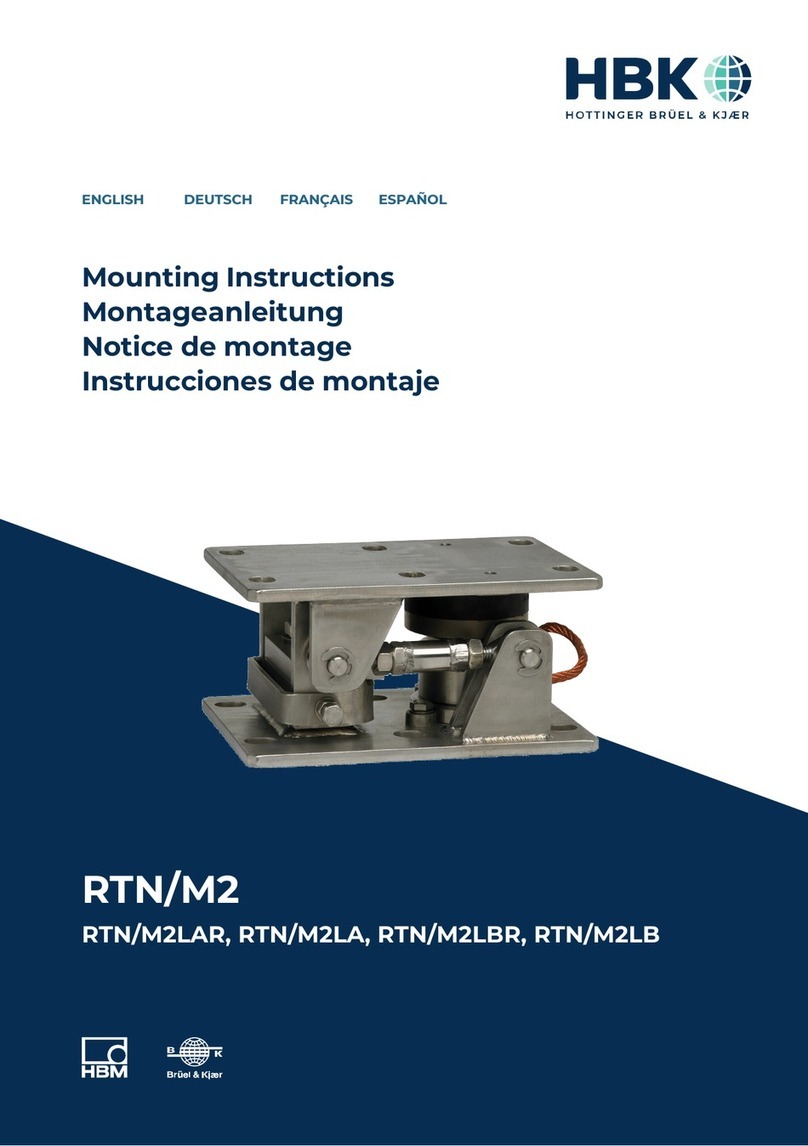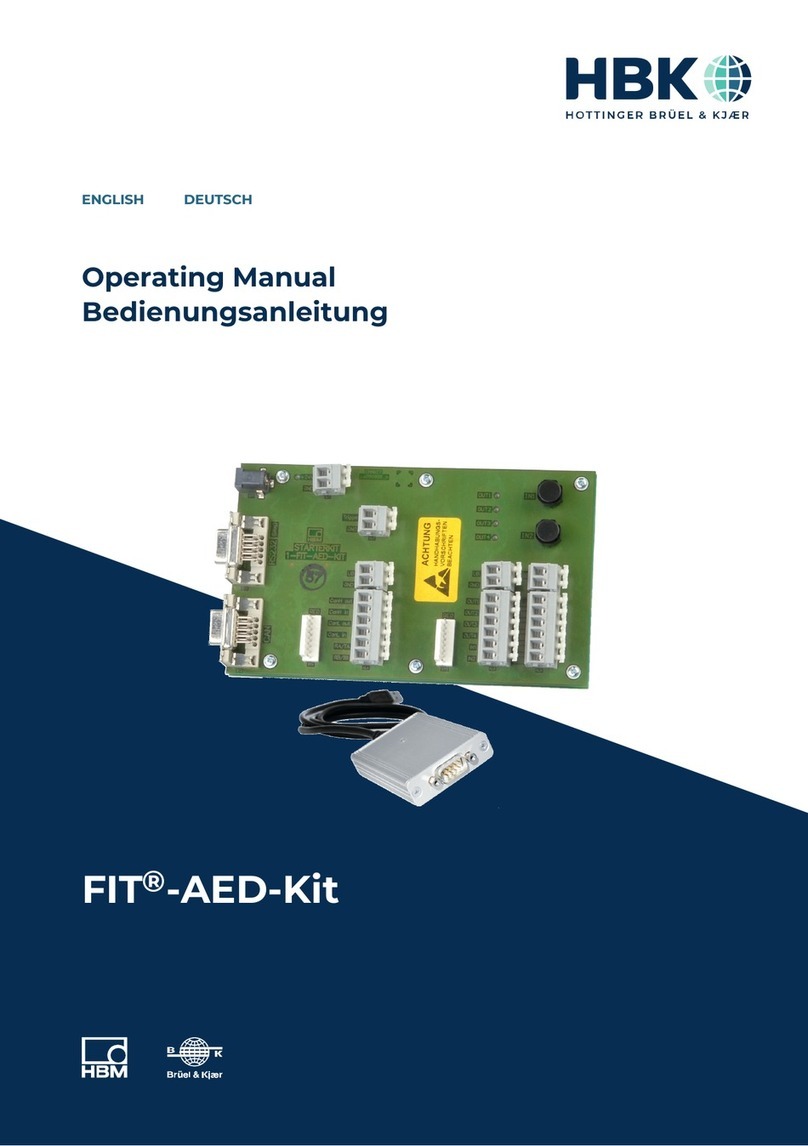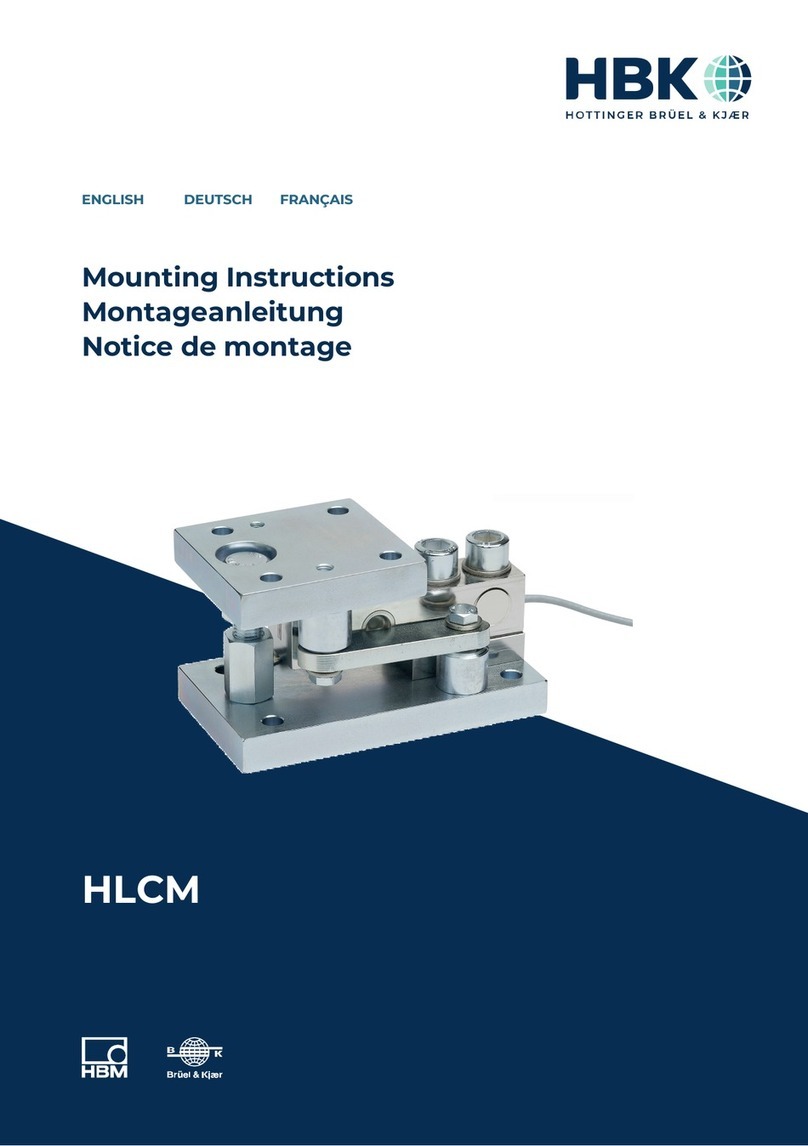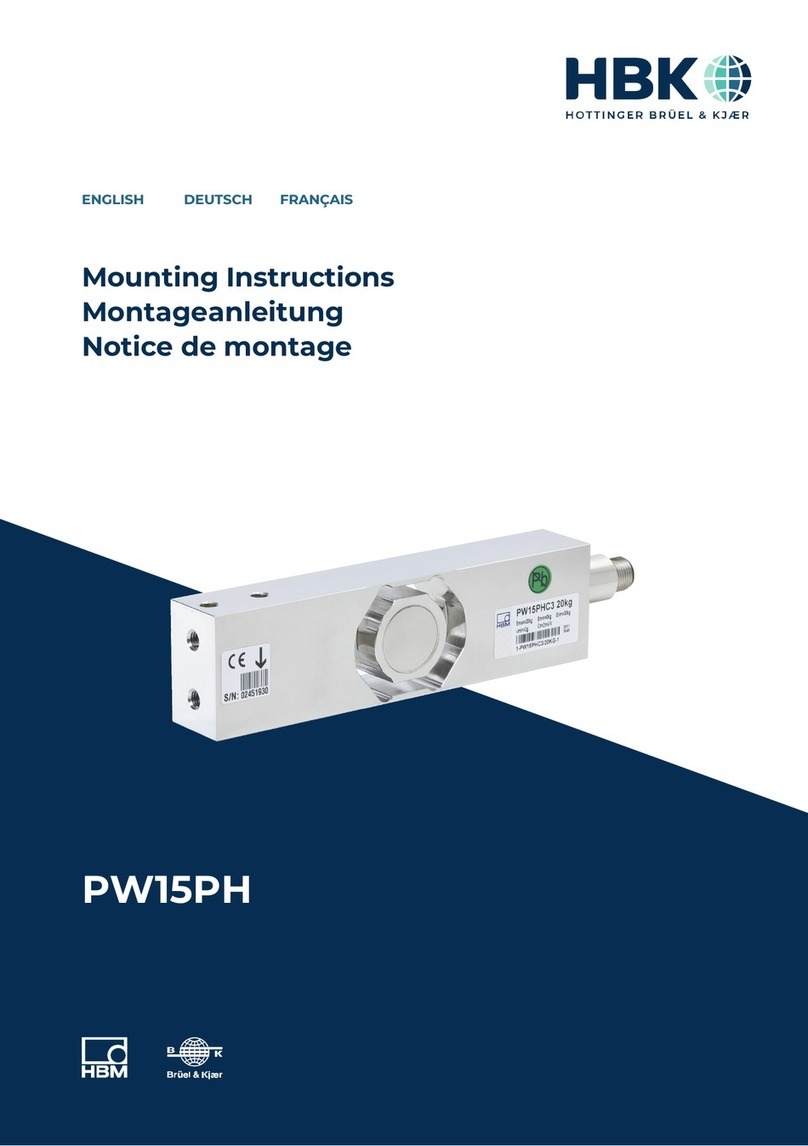HBK RTN User manual

RTN
ENGLISH DEUTSCH FRANÇAIS
Mounting Instructions
Montageanleitung
Notice de montage

Hottinger Brüel & Kjaer GmbH
Im Tiefen See 45
D-64293 Darmstadt
Tel. +49 6151 803-0
Fax +49 6151 803-9100
www.hbkworld.com
Mat.: 7-0101.0030
DVS: A01153 04 Y00 00
03.2023
EHottinger Brüel & Kjaer GmbH
Subject to modifications.
All product descriptions are for general information
only. They are not to be understood as a guarantee of
quality or durability.
Änderungen vorbehalten.
Alle Angaben beschreiben unsere Produkte in allge
meiner Form. Sie stellen keine Beschaffenheits- oder
Haltbarkeitsgarantie dar.
Sous réserve de modifications.
Les caractéristiques indiquées ne décrivent nos
produits que sous une forme générale. Elles
n'impliquent aucune garantie de qualité ou de
durabilité.

RTN
ENGLISH DEUTSCH FRANÇAIS
Mounting Instructions

RTN
TABLE OF CONTENTS
2
TABLE OF CONTENTS
1 Safety instructions 3................................................
2 Markings used 6....................................................
2.1 Markings used in this document 6.....................................
2.2 Symbols on the device 6.............................................
3 Application 7.......................................................
4 Mounting instructions 8.............................................
5 Electrical connection 10..............................................
5.1 Connection in a 4-wire configuration 10..................................
5.2 Plug connection (optional) 11..........................................
5.3 Parallel connection of several transducers 11............................
5.4 Shortening and extending the cable 12..................................
5.5 EMC protection 12...................................................
6 Corrosion protection and maintenance 14...............................
7 Specifications 15....................................................
8 Dimensions of the RTN... load cell 16...................................
9 Mounting accessories 18.............................................

3
RTN
SAFETY INSTRUCTIONS
1 SAFETY INSTRUCTIONS
Intended use
Load cells of the RTN…type series are designed for technical weighing applications
within the load limits detailed in the specifications. Any other use is not the intended use.
The load cells may only be installed by qualified personnel in compliance with the specifi
cations and with the safety requirements and regulations of these mounting instructions.
It is also essential to observe the applicable legal and safety regulations for the applica
tion concerned. The same applies to the use of accessories.
Load cells are not intended for use as safety components. Please also refer to the “Addi
tional safety precautions” section. Proper and safe operation of the load cells requires
proper transportation, correct storage, siting and mounting, and careful operation.
Load-carrying capacity limits
Comply with the data in the technical data sheets when using the load cells. The respec
tive specified maximum loads in particular must never be exceeded. Do not exceed the
values stated in the technical data sheets, for example, for
Slimit load
Slateral load limiting
Sbreaking loads
Stemperature limits
Slimits of electrical load-carrying capacity
Note that when several load cells are installed in a scale, there is not always an even load
distribution on the individual load cells.
Use as machine elements
The load cells can be used as machine elements. When used in this manner, it must be
noted that, to favor greater sensitivity, the load cell is not designed with the safety factors
usual in mechanical engineering. Please refer to the “Load-carrying capacity limits” sec
tion and the specifications.
Accident prevention
The applicable accident prevention regulations from employers’ liability insurance associ
ations must be taken into account, even though the stated load in the destructive range is
well in excess of the full scale value.

RTN
SAFETY INSTRUCTIONS
4
Additional safety precautions
Load cells cannot (as passive transducers) implement any (safety-relevant) cutoffs. This
requires additional components and constructive measures, for which the installer and
operator of the plant is responsible.
In cases where a breakage or malfunction of the load cells would cause injury to persons
or damage to equipment, the user must take appropriate additional safety measures that
meet at least the requirements of applicable safety and accident prevention regulations
(e.g. automatic emergency shutdown, overload protection, catch straps or chains, or
other fall protection).
The electronic processor that processes the measurement signal should be designed so
that failure of the measurement signal cannot lead to secondary failures.
General dangers of failing to follow the safety instructions
Load cells are state-of-the-art and reliable. Transducers can give rise to residual dangers
if they are mounted, installed, used and operated inappropriately or by untrained person
nel. Everyone involved with siting, starting up, operating or repairing a load cell must have
read and understood the mounting instructions and in particular the technical safety in
structions. Load cells may be damaged or destroyed by improper use or non-compliance
with the mounting and operating manual, these safety instructions or any other applicable
safety regulations (safety and accident prevention regulations of employers’ liability in
surance associations) when handling the load cells. Load cells can break, particularly if
overloaded. The breakage of a load cell can also cause damage to property or injury to
persons in the vicinity of the load cell.
If load cells are not used according to their designated use, or if the safety instructions or
specifications in the mounting and operating manual are ignored, it is also possible that
the load cells may fail or malfunction, with the result that persons or property may be
affected (due to the loads acting on or being monitored by the load cells).
The scope of supply and performance of the transducer covers only a small area of
weighing technology, as measurements with (resistive) strain gage sensors presuppose
the use of electronic signal conditioning. In addition, equipment planners, installers and
operators should plan, implement and respond to the safety engineering considerations
of the weighing technology in such a way as to minimize residual dangers. Pertinent na
tional and local regulations must be complied with.
Conversions and modifications
The design or safety engineering of the transducer must not be modified without our ex
press permission. Any modification shall exclude all liability on our part for any damage
resulting therefrom.
Resale
If the load cell is resold, these mounting instructions must be included with the load cell.

5
RTN
SAFETY INSTRUCTIONS
Environmental protection, disposal
In accordance with national and local environmental protection, material recovery and
recycling regulations, old transducers that are no longer serviceable must be disposed of
separately from normal household waste.
If you require more information about disposal, please contact your local authorities or
the dealer from whom you purchased the product.
Qualified personnel
Qualified personnel means persons entrusted with installing, mounting, starting up and
operating the product, who possess the appropriate qualifications for their function.
This includes people who meet at least one of the three following criteria:
1. Knowledge of the safety concepts of automation technology is a requirement and as
project personnel, you must be familiar with these concepts.
2. As automation plant operating personnel, you have been instructed how to handle the
machinery. You are familiar with the operation of the equipment and technologies
described in this documentation.
3. As commissioning engineers or service engineers, you have successfully completed
the training to repair the automation systems. You are also authorized to operate,
ground and mark circuits and equipment in accordance with safety engineering stan
dards.

RTN
MARKINGS USED
6
2 MARKINGS USED
2.1 Markings used in this document
Important instructions for your safety are highlighted. Following these instructions is es
sential in order to prevent accidents and damage to property.
Symbol Significance
Notice This marking draws your attention to a situation in
which failure to comply with safety requirements can
lead to damage to property.
Important This marking draws your attention to important in
formation about the product or about handling the
product.
Tip This marking indicates application tips or other
information that is useful to you.
Information This marking draws your attention to information
about the product or about handling the product.
Emphasis
See …
Italics are used to emphasize and highlight text and
identify references to sections, diagrams, or external
documents and files.
2.2 Symbols on the device
CE mark
With the CE mark, the manufacturer guarantees that the product
complies with the requirements of the relevant EC directives (the
Declaration of Conformity can be found on the HBM website
HBM (www.hbm.com) under HBMdoc).
Statutory waste disposal marking
In accordance with national and local environmental protection
and material recovery and recycling regulations, old devices that
can no longer be used must be disposed of separately and not
with normal household garbage. If you need more information
about disposal, please contact your local authorities or the
dealer from whom you purchased the product.

7
RTN
APPLICATION
3 APPLICATION
RTN ring torsion load cells are available in different variants for a wide range of maxi
mum capacities (1 to 470 metric tons). They are suitable for weighing all kinds of con
tainers and for large platform scales. They have a stainless steel body that lends them a
high IP rating and makes them suitable for use in harsh conditions. With their annular
strain gage, RTN load cells considerably minimize the influence of transverse and lateral
loads. A legal-for-trade weighing system up to 3,000 parts (as per OIML R60) is possible.

RTN
MOUNTING INSTRUCTIONS
8
4 MOUNTING INSTRUCTIONS
When mounting the load cells, pay attention to the following:
SPlease handle load cells with care!
SLoad cells are precision sensors and so their achievable accuracy depends greatly on
their being mounted correctly!
SUse suitable hoisting gear for mounting the weighing device!
SDo not overload load cells even briefly (e.g. due to unevenly distributed support
loads)!
SWhen carrying out adjustment work that could endanger the load cells, use supports
(dummies) of equal height!
SThe load must be introduced concentrically to the load application surface and in the
measurement direction of the load cell. Use convex thrust pieces with sufficiently
large radii (HBM accessory).
SAvoid lateral forces and torques (also see the “Specifications” section)!
SDepending on the construction, use anti-liftoff devices and limit stops if necessary!
SEnsure the force application points of the load cells are all on the same level. The
mounting accessories include shims for this purpose (see section 9)!
SProtect load cells against
-one-sided heat radiation
-the effects of subsequent welding work1))
-strong temperature variations!
STo prevent rapid wear, grease the force application part. Please take care not to use
too much grease, as this will cause the rubber ring of the cell to stick (from maximum
capacity >4.7 t)!
SThe optional cable with outer braided wire sheath is intended for use when there is
increased mechanical stress (e.g. damage caused by gnawing rodents). If this cable
is used, the outer braided wire is connected to potential equalization at least once, to
avoid accidental energization. This outer braided wire is not used to shield the load
cell. Instead, the inner braided wire of the load cell cable (also see section 5.5
“EMC protection”, page 12) is used for shielding.
1) Every load cell should be bridged with a twisted copper cable (e.g. EEK... from HBM = approx.
16 mm2) during or immediately after installation. This prevents damage due to welding currents.
Grounding the load cell reduces the risk of it sustaining damage due to lightning strikes.

9
RTN
MOUNTING INSTRUCTIONS
Notice
Load cells are precision measuring elements and need to be handled carefully. Dropping or
knocking the transducer may cause permanent damage. Make sure that the transducer
cannot be overloaded, including while it is being mounted.
Preparations for mounting
SThe installation space or foundations must be level and horizontal.
SThe base plate of the load cell has to satisfy certain special requirements: Thermal
expansion coefficient of 11·10-6/K; flatness less than 0.05 mm; roughness Ra 3.2;
hardness more than 40 HRC.
SFor correct function, always use the original HBM base plate. This is included with the
VEN and VPN installation accessory from HBM.
Mechanical sources of error
Lateral forces
SLoad acts on the load cell from other directions than the measurement direction, due
to incorrect mounting or insufficient bending stiffness of the construction.
During operation, lateral forces may occur in the following conditions:
1. Braking forces of a vehicle on a weighbridge
2. Deflections in the construction
3. Expansion in the construction due to raised temperatures
4. Wind forces when installed outdoors
5. Drive motors/mixers
If the lateral forces remain below the values specified in the data sheet, measurement
errors may occur but the load cell will not suffer any lasting damage.
If there is a risk that the permissible lateral forces may be exceeded, suitable measures
such as stay rods or buffers must be provided.
If the load cell is subjected to normal force, greater lateral forces dependent on the nor
mal force may be transferred due to base plate friction.
If high lateral forces can be expected in your application, we recommend the use of pen
dulum bearings from HBM to minimize the lateral forces dependent on the normal force
that acts on the load cell.
Also see section 1 “Safety instructions” on page 3.

RTN
ELECTRICAL CONNECTION
10
5 ELECTRICAL CONNECTION
The following can be connected for measurement signal conditioning:
SCarrier-frequency amplifiers
SDC voltage amplifiers
that are designed for strain gage measurement systems.
If rubber-metal bearings are used, the construction is insulated against the foundation.
Here, please pay attention to DIN/VDE 0100, Part 410 as regards the necessary potential
equalization.
5.1 Connection in a 4-wire configuration
(red)
(black)
(blue)
(white)
Bridge excitation voltage (-)
Bridge excitation voltage (+)
Signal (+)
Signal (-)
Sensing element (+)
Sensing element (-)
Extension cable
(6-wire configuration)
Load cell RTN…
(4-wire configuration)
(yellow) Shield
Measuring amplifier/weighing
electronics
(6-wire configuration)
Fig. 5.1 Cable assignment of RTN...
Electrical and magnetic fields often induce interference voltages in the measuring circuit
(also see section 5.5 “EMC protection”).
Notice
Do not open the screwed cable gland on the load cell under any circumstances; if it is
opened inadvertently, the load cell must be sent to the factory for repair.

11
RTN
ELECTRICAL CONNECTION
5.2 Plug connection (optional)
Plug-in contact 1 = measurement signal (-)
Plug-in contact 6 = excitation voltage (+)
Plug-in contact 5 = sense lead (+)
Plug-in contact 7 = excitation voltage (-)
Plug-in contact 3 = sense lead (-)
Plug-in contact 8 = measurement signal (+)
2
3
4
5
6
7
1
8
Plug-in contact 2 = not in use
Plug-in contact 4 = not in use
Fig. 5.2 Connector pin assignment
With this connector pin assignment, the output voltage at the measuring amplifier is posi
tive when the transducer is loaded. The plug is implemented in a 6-wire configuration.
When transducers in a 6-wire configuration are connected to amplifiers in a 4-wire config
uration, the sense leads of the transducers must be connected to the corresponding exci
tation voltage leads: Marking (+) with (+) and marking (-) with (-), see Fig. 5.2. This mea
sure also reduces the cable resistance of the excitation voltage leads.
However, there will be a voltage loss on the supply leads due to the cable resistance that
is still present and not compensated for by the 6-wire configuration. A large part of this
loss can be eliminated by a calibration, however, the temperature-dependent part re
mains. The pin assignment for the cables available as accessories can be found in data
sheet B03643.
5.3 Parallel connection of several transducers
Only load cells with an aligned output (nominal (rated) sensitivity and output resistance)
are suitable for parallel connection. Wire load cells in parallel by joining together the ca
ble terminations of the same color.
Important
In this case, if an individual load cell is overloaded, this will not be apparent from the out
put signal.

RTN
ELECTRICAL CONNECTION
12
(red)
(black)
(blue)
(white)
Bridge excitation voltage (-)
Bridge excitation voltage (+)
Signal (-)
Signal (+)
Sensing element (+)
Sensing element (-)
Extension cable
Junction box (e.g. “VKK...” or “VKEX” from HBM)
(yellow) Shield
Measuring amplifier
Weighing electronics
Fig. 5.3 Parallel connection of several transducers
5.4 Shortening and extending the cable
Use only shielded, low-capacitance measurement cables for extending the cable, making
sure there is a proper connection with minimal contact resistance.
To achieve full accuracy, a 6-wire configuration should be used to extend the cable all the
way to the subsequent electronics.
A 4-wire configuration is used for the load cells and the cable must not be shortened.
5.5 EMC protection
CAUTION
Electrical and magnetic fields often induce interference voltages in the measuring circuit.
To ensure reliable measurement, however, the transducer must be able to transmit signal
differences of a few μV to the analysis unit without interference.
Planning the shielding design
Due to the numerous application options and differing local constraints, we can only
provide you with general information on correct connection. The shielding design suitable
for your application must be planned locally by an appropriate specialist.
HBM load cells with shielded, round cables are EMC-tested in accordance with the
EU Directive and bear the CE mark. Voltage surges as per EN 61000-4-5 can give rise to
deviations from the load cell’s specified accuracy. These surges in plants are caused by
lightning strikes or switching operations in power circuits, for example, and disappear
again when interference is no longer active. This is particularly evident with cables over

13
RTN
ELECTRICAL CONNECTION
30 m long or if the equipment is used outdoors. Customers should take additional pre
cautions in these cases.
Please note:
SConnect the connecting cable shield all over the surface of the shielding electronics
housing. When using several load cells, connect the shields all over the surface of the
junction box (combination of transducer signals, e.g. type VKK2 from HBM). From
there, connect the measurement cable for the electronics over the surface of the
junction box and the shielding electronics housing.
SThe shield of the connecting cable must not be used for discharging potential
differences within the system. You must therefore lay sufficiently dimensioned
potential equalization lines to compensate for possible potential differences.
SUse shielded low-capacitance measurement cables only (HBM cables fulfill these
conditions).
SDo not route measurement cables parallel to electric cables, especially power lines
and control circuits. If this is not possible, protect the measurement cable, for
example with steel conduits.
SAvoid stray fields from transformers, motors and contact switches.
Important
Potential equalization is specified for applications in potentially explosive atmospheres.

RTN
CORROSION PROTECTION AND MAINTENANCE
14
6 CORROSION PROTECTION AND MAINTENANCE
Protect load cells against chemicals that could attack the cable or the steel of the hous
ing.
Notice
Acids and all substances that release ions also attack stainless steels and their weld
seams.
The resulting corrosion could cause the transducer to fail. If this is the case, you must pro
vide appropriate means of protection.
The transducer is basically maintenance free.
Dust, dirt and other foreign matter must not be allowed to accumulate sufficiently to di
vert some of the measuring force onto the housing, thus distorting the measured value
(force shunt).
Do not use hard or pointed objects to clean the transducer. The transducer achieves an IP
rating of IP68 (test conditions: 100 hours under 1 m water column) or, optionally, IP69K
(water at high pressure, steam cleaning), as per DIN EN 60529. The transducer is there
fore suitable for wet cleaning. Despite this, the transducer should be protected against
the long-term effects of moisture.

RTN
DIMENSIONS OF THE RTN... LOAD CELL
16
8 DIMENSIONS OF THE RTN... LOAD CELL
Scope of supply
Load cell with connecting cable
(red)
(black)
Bridge excitation voltage (-)(blue)
(white)
(green/yellow)
Bridge excitation voltage (+)
Signal (+)
Signal (-)
Shield
Cable assignment of RTN... / 1 t - 470 t
Thread depth
7 mm
View X
RTN... / ≤4.7 t RTN... / 10 t - 470 t
Plug version (optional)
View X
~27
~17
M
X
Ø16

17
RTN
DIMENSIONS OF THE RTN... LOAD CELL
RTN... jAjBjC H J K L M
1 t 49 20 60 43 - 7.5 5 m 10.5
2.2 t 49 20 60 43 - 7.5 5 m 10.5
4.7 t 49 20 60 43 - 7.5 5 m 10.5
10 t 74 30 75 50 7 6.5 5 m 8.5
15 t 75 30 75 50 7 6.5 5 m 8.5
22 t 75 30 75 50 7 6.5 15 m 8.5
33 t 95 40 95 65 7 10 15 m 8.5
47 t 130 60 130 75 7 14 15 m 8.5
68 t 130 60 130 85 7 14 15 m 8.5
100 t 150 70 150 90 7 16 15 m 8.5
150 t 150 70 150 100 7 16 5 m 8.5
220 t 225 100 225 130 10 24 5 m 11
330 t 225 100 225 144 10 24 5 m 11
470 t 270 120 270 170 10 28 5 m 11

RTN
MOUNTING ACCESSORIES
18
9 MOUNTING ACCESSORIES
VPN pendulum bearing
Scope of supply: Base plate, pendulum, centering bolt, centering flange, shims, grease,
screws
You can find more detailed information in the VPN mounting instructions at www.hbm.
com/rtn
VEN rubber-metal bearing
Scope of supply: Base plate, elastomer, centering flange, centering bolt, thrust piece (>4.7
t), shims, grease, screws
You can find more detailed information in the VEN mounting instructions at www.hbm.
com/rtn
Table of contents
Languages:
Other HBK Industrial Equipment manuals

